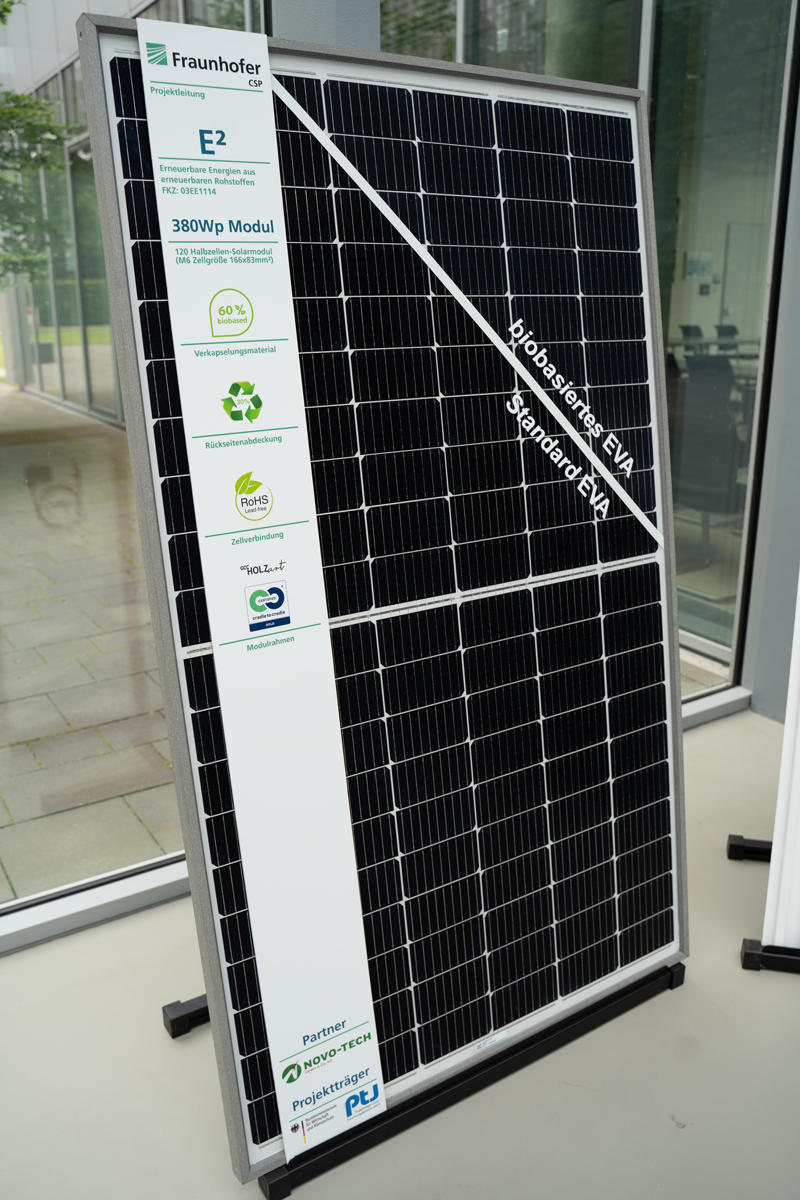Sustainability and resource efficiency in the photovoltaic industry will have a significant impact on the future of renewable energies. Currently, raw materials and materials are still being used in solar modules that cannot be recycled at all or can only be partially recycled and have weaknesses in terms of environmental compatibility. This is where the recently completed project “E2 - E-Quadrat. Renewable energies from renewable raw materials”. Together with partners, the Fraunhofer Center for Silicon Photovoltaics CSP in Halle (Saale) has developed a solar module in which the components that are not directly required for light-to-electricity conversion are made from biodegradable materials, recyclable materials or renewable raw materials.

The ecological footprint of the photovoltaic industry is often smaller than that of conventional energy sources. Photovoltaic systems produce no harmful emissions during their operation and therefore make a significant contribution to reducing air pollution and greenhouse gas emissions. However, if one considers the entire life cycle of solar modules - from the extraction of raw materials through production and use to disposal - weak points become apparent.
Current photovoltaic modules consist of glass, polymers, metals and silicon-based solar cells. The extraction of raw materials, especially silicon, can be harmful to the environment. The individual components are also rarely returned to the raw material cycle. At the end of the average operating phase and service life of solar modules, which is currently 20 to 25 years, the old PV modules are a valuable waste product that is difficult to separate and for which there is currently no concrete recycling concept. A large proportion of the components are currently either incinerated or “downcycled” into inferior products. Approaches for producing the materials used from renewable raw materials and at the same time reintegrating them into the cycle could make the solar industry even greener.
This is the starting point for the “E2 - E-Quadrat” project, which was funded by the German Federal Ministry for Economic Affairs and Climate Protection (funding reference 03EE1114). Together with NOVO-TECH GmbH, a team from Fraunhofer CSP developed and tested materials that are both highly reliable in the long term against all weather conditions and fully recyclable. “The project addressed all phases of a PV module's life cycle: From production from materials made from renewable raw materials through the actual operating phase to material recycling and return to the material cycle at the end of its service life,” says Ringo Köpge, research associate in the ‘PV Modules, Components and Manufacturing’ group at Fraunhofer CSP and project manager.
The 380 watt solar module, which was created as a “bio-module prototype” within the project, is characterized by four special features compared to conventional modules. The frame of the module has a high proportion of wood. This can be completely recycled at the end of the module's service life and fed back into module production. The module's cell connections are not connected with lead-containing solder, as is usually the case, but with an electrically conductive adhesive (ECA) containing silver particles that serves as a connector between the wires and the cells. Currently, only around three to four percent of modules are bonded by lead-free ECA. The back cover of the module consists of a film made from 30 percent recycled PET. The ethylene vinyl acetate film (EVA film), which is used as a transparent plastic layer in the production of solar modules and serves as encapsulation material for the cells, consists of 60 percent bio-based “sugar cane ethylene”. Currently, only EVA made from fossil raw materials is used for the modules, which has to be recycled or disposed of.
The team at Fraunhofer CSP subjected the individual components used to various tests, including accelerated ageing, heat, humidity and temperature cycling tests. It was shown that every component that was installed passed the latest module standards. The results can be used to improve the CO2 footprint in the future by using renewable raw materials and recycling the energy-intensive raw materials (silicon cell). By proving that biopolymers are also suitable for use in photovoltaics, they can be used for a variety of other complex outdoor applications in the future.
Ringo Köpge will be presenting the research results and the module at this year's EUPVSEC, which takes place in Vienna from September 23 to 27, under the title “Steps Towards a 100% Renewable Material Solar Module: Evaluating Material Substitutions for Encapsulation and Interconnection”.
 Fraunhofer Center for Silicon Photovoltaics CSP
Fraunhofer Center for Silicon Photovoltaics CSP